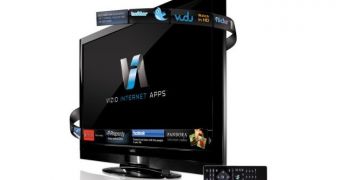The past year has seen the concept of smart TVs gaining quite a bit of popularity, especially with how more and more web-connected TV sets have been selling, but DisplaySearch seems a bit worried about the implications for the future.
Until late last year, most TVs didn't really have all that big a functionality besides their basic one, relying on cable or set-top boxes for content access.
Then, they started incorporating extra capabilities, not just display-related like 3D support, but other elements.
The list of new features includes such things as USB ports, for instance, though the truly successful asset was web connectivity.
There was even at least one product that incorporated PC-like traits, like its own storage drive, among other things, plus the same web access as above.
Simply put, Internet-connected HDTVs, like other home entertainment equipment, saw their popularity skyrocket in 2010.
In fact, such displays actually accounted for 21 percent of all HDTVs sold worldwide in 2010, a share that is only set to increase each year (the total shipments are expected to climb to 122 million by 2014).
DisplaySearch now fears that, should every possible web TV be used, the Internet broadband infrastructure would be overwhelmed.
“The looming risk now is what happens if every connected TV gets used,” said DisplaySearch director Paul Gray.
“With Netflix accounting for 20-percent of peak Internet traffic in the US, it’s reasonable to ask if the infrastructure can cope. Set makers need to understand that broadband access does not scale endlessly like broadcast reception,” he added.
This concern is raised because of the fact that smart TV manufacturers are used to how easily the model of traditional media distribution can scale in order to support a myriad of users.
Basically, IPTV services and the like are most likely not ready for that kind of sudden explosion in usage.

 14 DAY TRIAL //
14 DAY TRIAL //